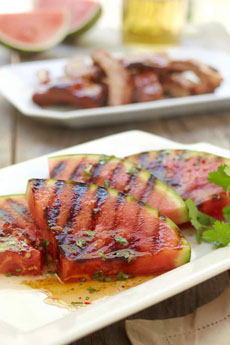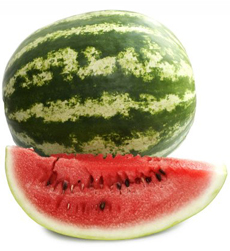A Guide To High-Antioxidant FoodPage 3: Antioxidant Terms & Definitions F To M
|
 Watermelon is high in the antioxidant lycopene. It can be enjoyed in many recipes. See our watermelon article for more information, along with this recipe for grilled watermelon. Photo courtesy Watermelon.org. |
|
|
FLAVONOID
A large group of water-soluble plant pigments, commonly referred to as bioflavonoids in the media. All flavonoids are biological in origin, so the two terms are interchangeable. Flavonoids are most commonly known as powerful antioxidants, protecting against oxidative and free radical damage. They have been referred to as “nature’s biological response modifiers” because of strong experimental evidence of their ability to modify the body’s reaction to allergens, viruses and carcinogens. They show anti-allergic, anti-inflammatory, anti-microbial and anti-cancer activity. As a result, consumers and food manufacturers have become interested in flavonoids for their medicinal properties, especially their potential role in the prevention of cancers and cardiovascular disease. The beneficial effects of fruit, vegetables, tea and red wine have been attributed to flavonoid compounds. Cocoa is loaded with the flavonoid epicatechin; cocoa has been found to have nearly twice the antioxidant content of red wine and up to three times that of green tea (dark chocolate should be consumed with a cocoa content of 70% or greater). Other good sources of flavonoids include all citrus fruits, berries, onions, parsley and legumes, plus green tea and red wine.
|
 Red wine is full of flavonoids. Photo courtesy Traipiche Vineyards. |
|
|
FREE RADICALS
Highly unstable and reactive molecules that attack, infiltrate and injure vital cell structures. They are constantly formed as a natural by-product of body chemistry. Free radicals are highly toxic and can damage important cellular molecules such as DNA, lipids or other parts of the cell, impairing the brain and other tissue. They are believed to accelerate the progression of age-related conditions and other diseases. |
 Green tea is a darling of the antioxidant crowd. Glass teapot and green tea from Rishi-Tea.com. |
|
|
GREEN TEA
All tea comes from the leaves of the Camellia sinensis plant (referred to as the tea tree, tea plant or tea bush); the difference in the many varieties of tea lies in the processing and the terroir (e.g. the difference in Indian versus Chinese versus Japanese growing environments, and different regional environments within countries). Unlike black and oolong teas, green tea is made from leaves that are not fermented before they are dried. Thus, the antioxidant levels of green tea are five times higher than black tea. Green tea is also high in vitamin C. Green tea is produced by panning freshly picked tea leaves at a high temperature for a short period of time to stop oxidation before it starts, which also preserves most of the polyphenols. (Note: See also white tea. White tea is also not fermented and is even higher in antioxidants.) Lutein is a xanthophyll and one of 600 known naturally occurring carotenoids. Lutein is synthesized only by plants and like other xanthophylls is found in high quantities in green leafy vegetables such as spinach and kale, and also in yellow carrots. |
 Leafy greens are good sources of lutein. Spinach photo courtesy GoodEggs.com. |
|
|
LYCOPENE
Lycopene is a bright red pigment and phytochemical found in watermelon, tomatoes, papayas and some other red fruits and vegetables (such as red carrots)—but not in strawberries or cherries. While most people think of tomatoes as a the best source of lycopene, watermelon actually has substantially more. |
 Watermelon has the largest concentration of lycopene. Photo courtesy Baldor Foods. |
Last Updated May 2018
© Copyright 2005-2025 Lifestyle Direct, Inc. All rights reserved. All images are copyrighted to their respective owners.